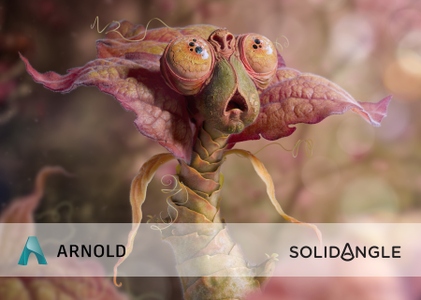
The software developer Solid Angle is pleased to announce the availability of Arnold (or MtoA) 4.2.3 for Autodesk Maya. This release introduces Arnold 6.2.1.1 and is a minor feature release bringing fixes and improvements to OCIO and USD support.
version 4.2.3 – Date: 07.06.2021
Enhancements
– Removed USD dependency on UsdProxyShapeTranslator (mtoa#657)
– Ship usd modules for multiple USD versions, allowing multiple versions of MayaUSD to be used (mtoa#658)
Bug Fixes
– mtoa#615 – crash creating OSL code editor in Maya 2022
– mtoa#625 – frame parameter is being set to seconds and not frame in the usd procedural
– mtoa#643 – mayapy crash with usdProxShape translator
– mtoa#644 – mayapy crash on loading pymel.core
– arv#560 – Upgrade OCIO to 2.0.1 in Arnold RenderView
– core#9900 Arnold can raise signals twice if they are handled by the host application
– core#10621 Artifacts or crashes when interactively changing object’s number of transform motion keys or shutter interval
– core#10511 Artifacts with implicit surface shapes
– core#10491 Crash due to NaN values in volume displacement
– core#10516 Crash when passing a null pointer to AiASSLoad()
– core#9425 Crash when updating the dependency graph after deleting a node
– core#10395 [GPU] Interactively editing a procedural transform does not update the included lights
– core#10377 Incorrect motion blur on visible quad and point lights when not using the default shutter
– core#10483 Large implicit surface shapes can cause slow or hung renders
– core#10488 Slowdown in stats output when ADP libraries are not found
– core#10528 [OCIO] Upgrade to bugfix release 2.0.1
– usd#795 GfMatrix4d attributes are not converted to AI_TYPE_MATRIX parameters
– usd#778 Procedural doesn’t read some animated parameters properly
– usd#790 Reset the disp_map parameter instead of setting nullptr when there is no displacement
– usd#768 Custom typed primitives are not written if they already exist
Arnold is an advanced cross-platform rendering library, or API, used by a number of prominent organizations in film, television, and animation, including Sony Pictures Imageworks. It was developed as a photo-realistic, physically-based ray tracing alternative to traditional scanline based rendering software for CG animation.
Arnold uses cutting-edge algorithms that make the most effective use of your computer’s hardware resources: memory, disk space, multiple processor cores, and SIMD/SSE units.
The Arnold architecture was designed to easily adapt to existing pipelines. It is built on top of a pluggable node system; users can extend and customize the system by writing new shaders, cameras, filters, and output driver nodes, as well as procedural geometry, custom ray types and user-defined geometric data. The primary goal of the Arnold architecture is to provide a complete solution as a primary renderer for animation and visual effects.
Introducing Arnold 6
Arnold for Maya is an advanced Monte Carlo ray tracing renderer built for the demands of feature-length animation and visual effects. It uses the Open Shading Language to define the materials and textures. Arnold for Maya (or MtoA) provides a bridge to the Arnold renderer from within Maya’s standard interface.
Introduction to Solid Angle’s Arnold Renderer
Solid Angle is leading provider of rendering software for animation and visual effects. The Arnold team believe that accurately and efficiently computing light transport in CG scenes is the best way to create stunning imagery for films and TV. Developers strive to provide clients with the best rendering tools to efficiently create realistic images.
Solid Angle is a wholly owned subsidiary of Autodesk Inc, and has its offices in Madrid and London.
Product: Solid Angle Maya to Arnold
Version: 4.2.3
Supported Architectures: x64
Website Home Page :www.arnoldrenderer.com
Languages Supported: english
System Requirements: PC *
Size: 1.1 Gb
– Maya 2019, 2020 or 2022
– Windows 10 or later, with the Visual Studio 2019 redistributable.
– CPUs need to support the SSE4.1 instruction set.
– GPU rendering works on Windows and Linux only and requires an NVIDIA GPU of the Ampere, Turing, Volta, Pascal, or Maxwell architecture. We recommend using the 460.39 or higher drivers on Linux and 461.40 (Quadro), 461.40 (GeForce), or higher on Windows. See Getting Started with Arnold GPU for more information.
– Optix denoiser requires an NVidia GPU with CUDA Compute Capability 5.0 and above.
Maya Plugins Compatibility
MtoA 4.2.3 works with the following Maya plugins
– Bifrost Extension for Maya 2.2.1.1
– MayaUSD 0.9.0
DOWNLOAD LINK